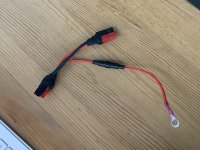I finally have a fix that's worked for hundreds of miles. Following the experiences of others in this thread taking steps to mediate electromagnetic noise picked up by the signal wiring, I took a different approach by looking for potential sources of that noise.
The most accessible suspect is a 50cm cable run between the battery and controller. The cable that came with the rest of the kit is unshielded, with parallel conductors. Twisted wire sets and/or shielding should be the default for any system handling both high loads and signal traffic. That cable went straight to the scrap pile. I replaced it with a pair of 10 AWG wires wound up by hand as a twisted pair.
The next suspect is the motor cable. It looks a lot like the phase wires are parallel and unshielded. Before going to the substantial effort of fixing that, I temporarily re-routed it through space, away from the frame as much as possible.
The PAS has worked perfectly ever since. I eventually moved the motor cable back against the frame, and that hasn't caused any trouble with the PAS. Twisted pair battery wiring mediated enough electromagnetic noise to solve my PAS issues. No more PAS crashes, no more wacky watt readings, no more feedback effects.100 watts of torque signal doesn't randomly turn into full throttle thanks to power crosstalk amplifying the torque signal in a feedback loop. Pedal assist stops when pedaling stops, not seconds later. PAS is actually safe to use now in traffic or while riding near other people.
I'll probably replace the PAS extension with proper shielded wiring eventually, but first I want to kill the rest of the noise sources.The gmac motor cable is next, because the speedometer and thermistor signals go howling all over the place in a pattern consistent with motor speed and load.
The most accessible suspect is a 50cm cable run between the battery and controller. The cable that came with the rest of the kit is unshielded, with parallel conductors. Twisted wire sets and/or shielding should be the default for any system handling both high loads and signal traffic. That cable went straight to the scrap pile. I replaced it with a pair of 10 AWG wires wound up by hand as a twisted pair.
The next suspect is the motor cable. It looks a lot like the phase wires are parallel and unshielded. Before going to the substantial effort of fixing that, I temporarily re-routed it through space, away from the frame as much as possible.
The PAS has worked perfectly ever since. I eventually moved the motor cable back against the frame, and that hasn't caused any trouble with the PAS. Twisted pair battery wiring mediated enough electromagnetic noise to solve my PAS issues. No more PAS crashes, no more wacky watt readings, no more feedback effects.100 watts of torque signal doesn't randomly turn into full throttle thanks to power crosstalk amplifying the torque signal in a feedback loop. Pedal assist stops when pedaling stops, not seconds later. PAS is actually safe to use now in traffic or while riding near other people.
I'll probably replace the PAS extension with proper shielded wiring eventually, but first I want to kill the rest of the noise sources.The gmac motor cable is next, because the speedometer and thermistor signals go howling all over the place in a pattern consistent with motor speed and load.


